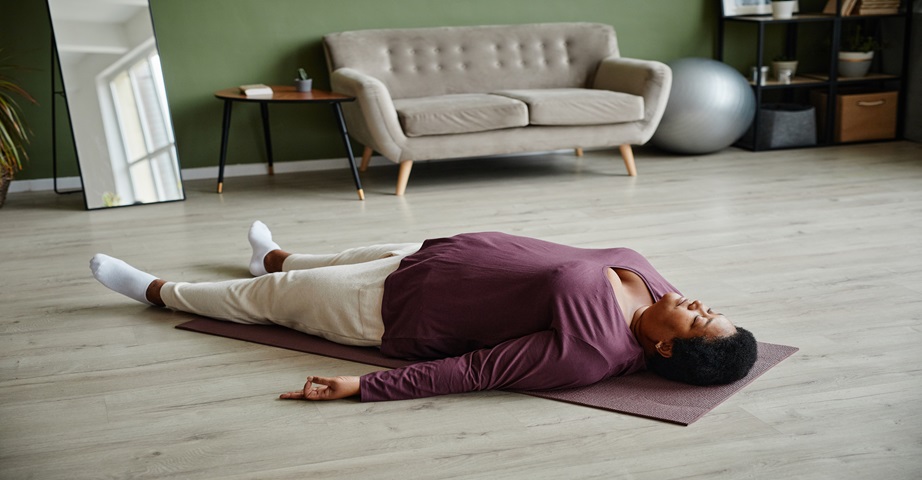Yoga nidra (yoga of sleep) - What is it? What are the benefits? Find out!

Yoga Nidra is a form of meditation recognized as an effective technique for deep relaxation. It doesn’t require complex postures and focuses primarily on relaxing the body and mind. This practice can offer numerous benefits, including improving sleep quality and reducing stress levels. What exactly is yoga nidra? What does “joga nidra” mean in Polish? What effects does yoga before sleep have? Who should consider practicing conscious rest?
Table of contents
- What is yoga nidra?
- How does yoga Nidra Work for Sleep? The process of deep relaxation
- Who is yoga nidra for? See if it’s right for you!
- Yoga nidra - effects and benefits
- Yoga nidra - precautions and contraindications
- How to prepare for yoga nidra practice?
- 8 Stages of Yoga Nidra - the key to deep calm and harmony
- Nidra vs. hypnosis - are they the same?
- Yoga nidra - summary
What is yoga nidra?
Yoga Nidra, also known as yoga nidra or yoga of sleep, is a meditation technique that enables relaxation of both mind and body. It is a state between wakefulness and sleep, promoting deep relaxation by guiding the body into a restful state of consciousness, allowing the senses to withdraw from the external world inward.
Yoga nidra is an ancient meditation technique originating from a method called nyasa, dating back to the 7th and 6th centuries BCE. It comes from India and was popularized in the mid-20th century by the Hindu teacher Satyananda Saraswati, who regarded yoga nidra as a method for accessing the deeper layers of the mind.
How does yoga Nidra Work for Sleep? The process of deep relaxation
Yoga nidra is practiced lying on the back, typically in the Savasana pose (corpse pose), which allows the body to relax and muscles to release tension. Guided by an instructor’s voice, this meditation brings the body to a state of wakefulness almost bordering on sleep. During sessions led by a qualified guide, verbal cues direct attention to the breath, mind, or body, gently moving practitioners through stages of relaxation.
While the body remains inactive, the mind stays fully aware in deep meditation, activating specific brain waves. Science distinguishes four main brain wave frequencies: beta (awake and alert), theta (associated with sleep), and delta (unconsciousness). During yoga nidra, alpha waves dominate, linked to passive awareness of the body.
Breathwork plays a crucial role in this practice, alongside meditation, relaxation, and sankalpa – a resolve or intention. This process influences the body by using repetitive stimuli to trigger responses in both body and mind, shifting awareness inward to internal sensations.
Recommended accessories and dietary supplements
Who is yoga nidra for? See if it’s right for you!
Yoga nidra can be practiced by nearly anyone, regardless of age, gender, or physical ability. It requires no complex postures or physical skills, making it accessible to anyone seeking relaxation and mental calm. It is especially recommended for those:
- struggling with falling asleep or insomnia
- dealing with anxiety, chronic stress, or depression
- managing chronic pain
- working to increase self-awareness
- looking for effective relaxation methods
Interestingly, in the United States, yoga nidra is also used by military personnel as part of therapy for post-traumatic stress disorder (PTSD).
Yoga nidra - effects and benefits
Yoga nidra exercises are popular for their many potential benefits. Research shows that yoga before sleep can reduce muscle tension, lower stress and anxiety, improve mood, and decrease cortisol levels. Additionally, yoga nidra may enhance brain plasticity, boosting memory, and improve sleep quality by reducing difficulties with falling asleep and insomnia. Some findings suggest that one hour of yoga nidra can be equivalent to four hours of sleep in terms of restorative relaxation.
Moreover, yoga nidra can strengthen the immune system, improve creativity and focus, and reduce mental tension. It also helps regulate emotions, making it easier to cope with challenges and intense feelings. Furthermore, the practice increases body awareness and self-acceptance, and may help lower blood pressure, promoting emotional distance from daily stresses.
Yoga nidra - precautions and contraindications
Yoga nidra is generally considered a safe practice suitable for most people. However, it is recommended primarily for individuals with stable mental health. Those suffering from schizophrenia, personality disorders, sensory hypersensitivity, bipolar disorder, or psychosis should consult a doctor before starting yoga nidra to avoid worsening symptoms or psychosomatic issues.
People with epilepsy should also exercise caution, as the deep relaxation state may increase the risk of seizures, as well as individuals with Tourette’s syndrome.
How to prepare for yoga nidra practice?
Beginners should ideally start with sessions led by a qualified instructor who can explain the technique and help focus on correct practice. However, yoga nidra can also be done independently at home, using guided recordings by experienced teachers. When choosing a session, it’s helpful to select recordings that fit your goals and preferences.
Before starting, wear loose, comfortable clothing that won’t restrict movement. Find a quiet, calm, and warm space free from distractions to fully relax. The best time for yoga nidra is usually in the evening before bedtime, though it can be practiced at other times during the day.
Some wonder if additional accessories like a yoga mat, blanket, or pillow are necessary. Instructors suggest using whatever enhances comfort – whether that’s lying on a mat under a blanket or simply using a pillow under the head.

8 Stages of Yoga Nidra - the key to deep calm and harmony
Yoga Nidra follows a structured process of eight progressive relaxation stages. While experienced practitioners may not pay close attention to each stage during sessions, knowing them can be helpful, especially when practicing alone.
- Internalization - Settling the Body
Practice begins in Savasana with eyes closed. It’s important to relax muscles and listen to external sounds while calming the mind. - Sankalpa - Setting an Intention
At the start, practitioners mentally affirm a clear, positive, and brief intention relevant to their current life situation. This sankalpa is repeated with full conviction. - Rotation of Consciousness
Attention moves to different parts of the body as guided, without physically moving them. - Awareness of Breath
Focus shifts to the breath, observing it passively without trying to change its rhythm or depth. - Sensations and Feelings
Practitioners are asked to experience opposing sensations, like warmth/cold, anxiety/calm, or heaviness/lightness, linking these feelings to specific situations or bodily states, aiding emotional release and acceptance. - Visualization
Various visualization techniques are used, often involving quick mental images, words, or objects connected to emotions and memories, helping focus the mind and release hidden feelings. - Sankalpa Repetition
The initial intention is repeated mentally three times with deep commitment. - Externalization - Ending the Practice
The guide gently helps bring awareness back to the external environment. Practitioners slowly move their body parts and stretch to finish the session.
The full eight-stage yoga nidra session usually lasts about 40-45 minutes. Many opt for a shorter, four-stage version lasting about 20 minutes.
Nidra vs. hypnosis - are they the same?
Yoga nidra is often compared to hypnosis because both induce deep relaxation while accessing the subconscious mind. However, they differ in technique.
In yoga nidra, the practitioner remains conscious and is encouraged not to fall asleep, maintaining active awareness during deep relaxation. In contrast, during therapeutic hypnosis, consciousness is subdued, and users typically don’t remember their experiences afterward. In hypnosis, the therapist guides the mind, whereas in yoga nidra, the practitioner controls their own mind.
Yoga nidra - summary
Yoga Nidra is a safe, meditative method for deep relaxation and mental rest. It’s a simple practice suitable for nearly everyone, especially those dealing with insomnia or sleep difficulties. It can be done at home or in a class, individually or in groups, under the guidance of an experienced instructor following proven techniques.

